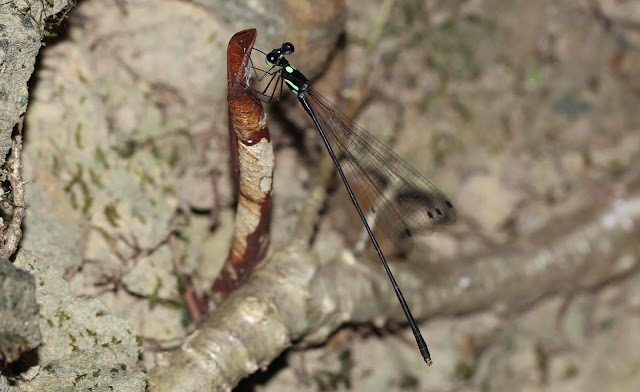*Adjusted after email conversation with Oleg.
A. pallidum changed into
A. hisopa.
Aciagrion is quite a speciose and difficult genus, not in the least because many of its members are tiny and thus vulnerable. Thank God that Kosterin et al. (2014) at least sorted the problem of
Aciagrion approximans. I had already recorded this species from Cat Tien National Park (a teneral male), but could only ID it properly after the mess surrounding A
. tillyardi had been resolved. And I recorded
A. borneense and
A. migratum already. But there are other species in the area and there were historical records of
A. hisopa,
A. occidentale, and
A. pallidum (Do & Dang).
This spring turned out to be quite productive.
Aciagrion approximans turns out to be in fact quite common in Lam Dong Province, where I saw large numbers, but I also recorded it from Quang Tri and Thua Thien - Hue Provinces. It stands out with its typical purplish violet color and in hand has deeply cleft superior appendages in lateral view, but with the dorsal and ventral edges parallel.
On June 11, 12 and 18 I observed
Aciagrion hisopa at the same locations as where I recorded
Platylestes platystylus (see previous post). All observed specimens were blue and the females did not have reddish abdomens, like
A. pallidum would.
A. pallidum and
A. hisopa have very similar appendages and blue specimens can be confusing. In both species the lines on the thorax can be diffuse, although they only become truly black in
A. hisopa.
On June 18, again at the same site in Dak Lak Province, I noticed another small species with triangular black mark on the dorsum of S8. Otherwise it was similar to
A. borneense, which also occurred there, but I thought it might be
A. occidentale. The appendages in lateral and dorsal view are virtually identical, but there is one important additional clue and that is that the internal surface of the superior appendages and the complete inferiors are ivory white in
A. borneense.
The last species to mention is a blue-and-black species from Thua Thien - Hue Province. I discussed these specimens with Oleg Kosterin and we concluded that it cannot be separated from
A. migratum on the basis of its appendages, even if it has a different hue. More research would be necessary to separate it (for instance through DNA analysis), but for now it seems better to treat it as a variant of
A. migratum.
 |
| Aciagrion occidentale male, note the triangular mark on S8. |
 |
| Probably the same male in flight |
 |
| Aciagrion occidentale, female |
 |
| Male Aciagrion hisopa, June 12, Lam Dong Province. Note the lack of black on the thorax |
 |
| Female Aciagrion hisopa, June 18, Dak Lak Province |
 |
| Another male, June 18, Dak Lak Province |
 |
| A typical Aciagrion approximans, a study in violet, May 2016, Lam Dong Province |
 |
| And finally Aciagrion migratum, Thua Thien - Hue Province, June 21. If you look carefully you can see the deeply incised superior appendages, but unlike in A. approximans the dorsal and ventral edges diverge. |




















































